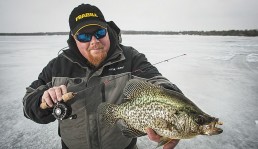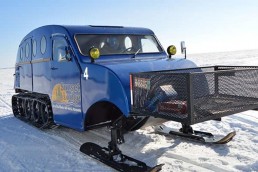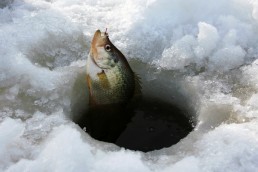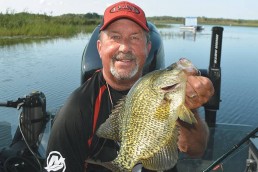Icing More Slab Crappies
SHARE THIS POST
The best time to search for winter crappies is actually in the fall, when I can run the water in my boat and find likely spots using my depthfinder and GPS.
Once I have potential winter crappie locations marked on my GPS, and the coordinates can easily be transferred from the Humminbird Onix unit on the boat to the ICE unit that I use during ice-fishing season.
If I am not able to do my homework during the fall, then I have to drill out the lake the old fashioned way. I use a 6-inch auger bit to search, and an 8-inch bit for additional holes in places that I’ve found fish.
Finding winter crappies
Crappies in most lakes will already be near their winter locations by the time the surface water temperatures drop below 50 degrees, so there is a window of opportunity every year to do some “pre-ice fishing season” homework.
Every lake is unique, but there are enough similarities between lakes for anglers to make an educated guess to where the crappies likely will be located, based on the type of lake.
Lakes with plenty of deep water with only one basin area are usually easier to pattern than lakes with several basins in different areas. Most deep-water crappies feed heavily on zooplankton during the winter and supplement their diet with minnows and other insects. The edges between the hard bottom and softer mud, and turns on the edge of the basin are often the key areas. Crappies also love basin areas near or between structures, so they have something geographical to relate to instead of roaming more open water.
Crappies living in shallow lakes usually have a higher percentage of their population feeding on minnows and insects and only supplement their diet zooplankton. Shallow crappies are more likely to relate to standing vegetation, shoreline breaks or more subtle structural elements.
Large lakes, like Lake of the Woods and Rainy Lake, might have crappies seeking out a completely separate bay or section of the lake with a mud basin, offering the structural elements crappies want during the winter.
To help check areas, I use an underwater camera system. I love multi-color sonar units like Humminbird’s Ice55. You can learn to recognize the blue- or green-colored layer of “stuff” that seems to lift off bottom as night approaches. This “stuff” is zooplankton, with crappies sifting through the thicker areas with the highest concentration of zooplankton. Crappies feeding on zooplankton will have what looks like black “mush” in their stomachs once successful anglers fillet them.
Crappies in deep lakes are usually located in the mud basin somewhere between 25 and 45 feet of water. These fish in shallow lakes are usually near standing weed edges or along any area with an abrupt depth change, even if it is only a couple of feet.
Are you enjoying this post?
You can be among the first to get the latest info on where to go, what to use and how to use it!
Crappies in both deep and shallow lakes like “isolated open water,” which means they prefer to use basin areas that are close to some structural element rather than basin areas in the middle of nowhere. They also like to have separate feeding and resting areas and make feeding movements between the two areas when they get active. This species in lakes with fewer structural elements means they will be more concentrated into the few areas that have the right combination of food and structure.
Lakes with several basin areas and more complex features can still be predictable, but the crappies may be more particular about what type of areas they are using. Once an angler “cracks the code” for the lake, they can use that information to locate other similar areas that may also be holding the winter crappies.
Timing the bite
Crappies often make their feeding runs the same time of each day, especially during stable weather. Once anglers find a location the crappies are using, they should be able to pattern the time of day these fish are following. It is often a matter of being in the right place at the right time.
Anglers may have to use trial and error and make multiple moves to find a location on the path of feeding crappies. Some lakes may be morning lakes; other lakes may have the best bite in the evening or after dark.
My favorite crappie baits
Crappies usually like smaller presentations. Their mouths are soft and tear easy (paper lips), so anglers need to use hooks with some bite or they may lose too many fish.
Northland’s smaller Puppet Minnows are effective for me on iced-over crappies. In fact, they often outproduce live bait. Anglers with the right jigging pattern can make a Puppet Minnow look just like the real thing, only with super-sticky hooks. And the Northland Sliver Spoon is a “Tungsten“ bait, so it fishes small but heavy, and you can get back down to the fish fast.
Northland also makes a series of Bro Bugs, designed to catch panfish. They can be tipped with scented Impulse plastics, waxworms or maggots, depending on what the fish seem to want.
When all else fails, crappies can always be caught on a minnow and a plain hook with a split shot under a perfectly balanced bobber (float), so the fish can’t feel the pressure of the bobber when they take the bait. If they will bite on scented plastics or artificial lures without bait, then anglers don’t have to take time to re-bait hooks after missed bites or after catching a fish.
Crappies usually start the winter close to the bottom and suspend farther off the bottom as the snow cover on the lakes begins to block out some of the sunlight. Good electronics are essential for anglers to see them and get their baits at or just above the eye level of the fish.
Please note that the crappies are fragile when fishing in depths over 24 feet. Refrain from sorting or catch-and-release of deep-water crappies, due to the potential of delayed mortality. Keep what you need. You can always go back out there after you eat the fresh fish you keep today.
MWO
SHARE THIS POST
Did you enjoy this post?
You can be among the first to get the latest info on where to go, what to use and how to use it!
Brian 'Bro' Brosdahl
Outdoor communicator Brian “Bro” Brosdahl lives in northern Minnesota. He is a walleye guide in the Cass Lake, Leech Lake and Lake Winnibigoshish areas. He is sponsored by Northland Fishing Tackle, Frabill/Plano, Aqua-Vu, Humminbird/Minn Kota, St. Croix Rods, Ranger Boats, and Evinrude. Guide inquiries: brosguideservice.com. Follow on social media.



